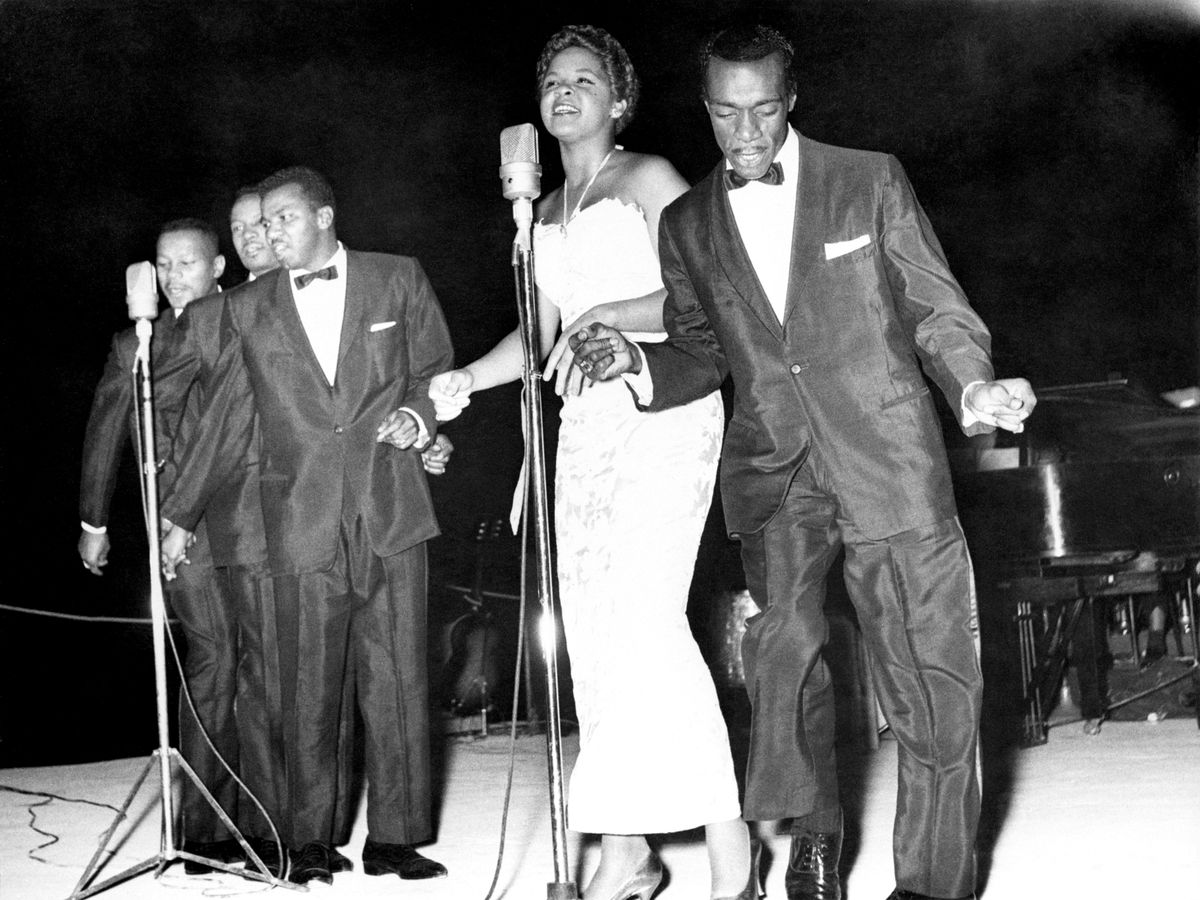Home>Genres>Rock>How Was Rock Different From Previous Popular Music Forms? ( 3 Ways)


Rock
How Was Rock Different From Previous Popular Music Forms? ( 3 Ways)
Modified: March 11, 2024
Discover how rock music revolutionized the music world through its distinctive sound, rebellious lyrics, and energetic performances. Explore the three key ways rock set itself apart from previous popular music forms.
(Many of the links in this article redirect to a specific reviewed product. Your purchase of these products through affiliate links helps to generate commission for AudioLover.com, at no extra cost. Learn more)
Table of Contents
Introduction
Rock music has long been recognized as one of the most influential and enduring genres in the history of popular music. Its impact on the music industry, culture, and society as a whole is undeniable. But what sets rock music apart from its predecessors? How did it differ from previous popular music forms?
To fully grasp the unique characteristics of rock music, it’s important to understand its evolution. Prior to the emergence of rock, popular music was largely dominated by genres such as jazz, blues, and folk. These genres, while influential in their own right, did not possess the same raw energy, rebellious spirit, and power that would come to define rock music.
Rock music emerged in the mid-20th century as a direct result of various musical styles and cultural movements. It combined elements of rhythm and blues, country, and gospel music to create a distinct sound that resonated with a younger generation hungry for change and self-expression.
In this article, we will explore three key ways in which rock music differed from previous popular music forms. From its rhythmic complexity to its bold instrumentation and lyrics, rock music revolutionized the music landscape and left an indelible mark on generations to come.
Evolution of Popular Music
Before diving into the characteristics that set rock music apart, let’s briefly trace the evolution of popular music leading up to its emergence. Popular music has always evolved and adapted to reflect the changing times and tastes of the listeners.
In the early 20th century, jazz was the dominant genre in popular music, with its lively rhythms and improvisation capturing the hearts of audiences. Blues music, rooted in African American traditions, also gained popularity during this time, thanks to its soulful vocals and emotional depth.
As the decades progressed, new genres emerged, such as swing, big band, and crooners in the 1930s and 1940s. These styles showcased charismatic performers and intricate orchestral arrangements.
By the 1950s, rock and roll burst onto the scene. Drawing heavily from rhythm and blues, country, and gospel music, this genre was louder, faster, and more rebellious than anything that had come before. Artists like Elvis Presley, Chuck Berry, and Little Richard brought the raw energy and charisma that would define rock music.
The 1960s marked a period of immense creativity and experimentation in music. The Beatles, The Rolling Stones, and The Who were at the forefront of the British Invasion, introducing a new sound and style influenced by rock and roll, rhythm and blues, and folk music. Meanwhile, in the United States, Bob Dylan revolutionized songwriting with his introspective lyrics and folk-rock sound.
The 1970s saw the rise of various subgenres, including psychedelic rock, glam rock, and progressive rock. Bands like Led Zeppelin, Pink Floyd, and Queen pushed the boundaries of rock music, incorporating elaborate instrumentation, complex song structures, and thought-provoking themes.
The 1980s witnessed the emergence of new wave, punk rock, and heavy metal, each with their own distinct characteristics and fan bases. This decade also saw the commercialization of rock music, with the rise of MTV and the increased emphasis on image and style.
Since then, rock music has continued to evolve and diversify, giving rise to alternative rock, grunge, indie rock, and more. While it may no longer dominate the charts in the same way it once did, its influence and legacy remain strong.
Now that we have a brief understanding of the evolution of popular music, let’s explore the specific characteristics that make rock music distinct from its predecessors.
Characteristics of Rock Music
Rock music is defined by a combination of musical elements and cultural influences that set it apart from previous popular music forms. These characteristics contribute to its distinct sound, energy, and impact on listeners. Let’s explore three key aspects that make rock music unique.
-
Rhythmic Complexity
One of the defining features of rock music is its rhythmic complexity. Unlike the simpler rhythms found in many previous popular music forms, rock music often incorporates intricate beats, syncopation, and dynamic changes. The driving force of the rhythm section, typically consisting of drums, bass, and rhythm guitar, creates a strong and pulsating foundation for the music. This complexity adds a level of excitement and intensity, making rock music a powerful and engaging genre.
-
Instrumentation and Sound
Another notable characteristic of rock music is its instrumentation and sound. Rock music typically features electric guitars, drums, bass guitar, and vocals as the core components. The electric guitar, with its ability to produce a wide range of tones and effects, has become synonymous with rock music. The use of distortion, feedback, and power chords contributes to the edgy and aggressive sound that sets rock apart. Additionally, the inclusion of keyboards, horns, and other instruments can add depth and variety to the sonic landscape of rock music.
-
Lyricism and Themes
Rock music often deals with introspective, rebellious, and socially aware themes, setting it apart from the subject matter of many previous popular music forms. Rock lyrics tackle a wide range of topics, including love, politics, social issues, personal struggles, and existential questioning. The lyrics can be poetic, provocative, and thought-provoking, resonating with listeners on a deeper level. Whether it’s expressing youthful rebellion, questioning authority, or reflecting on the human condition, the lyrical content of rock music adds another layer of complexity and emotional depth to the genre.
These three characteristics – rhythmic complexity, instrumentation and sound, and lyrical themes – combine to create the distinct and powerful genre that is rock music. It has become a platform for artistic expression, innovation, and cultural commentary, capturing the hearts and minds of millions of fans worldwide.
Rock music continues to evolve and adapt, incorporating new influences and pushing boundaries. Despite the ever-changing musical landscape, the enduring impact and legacy of rock music are undeniable.
Rhythmic Complexity
A notable characteristic that sets rock music apart from its predecessors is its rhythmic complexity. Unlike the simpler rhythms found in many previous popular music forms, rock music often incorporates intricate beats, syncopation, and dynamic changes. This rhythmic complexity adds a layer of excitement and intensity, contributing to the distinct energy that is synonymous with rock music.
At the heart of the rhythmic complexity in rock music is the rhythm section, typically consisting of drums, bass, and rhythm guitar. The drummer plays a pivotal role in driving the rhythm forward, with powerful and precise beats that create a solid foundation for the music. The bass guitar adds depth to the rhythm section, providing a melodic and rhythmic anchor that interacts intricately with the drums. The rhythm guitar further enhances the complexity by adding chord progressions and variations, complementing the bass and drums.
Syncopation, a common technique in rock music, adds a sense of unpredictability and excitement. It involves accentuating off-beats or unexpected rhythms, giving a distinctive groove to the music. This rhythmic interplay and syncopation make rock music captivating and dynamic, compelling listeners to move and groove to the rhythm.
In addition to syncopation, another element of the rhythmic complexity in rock music is the use of dynamic changes. Rock songs often feature contrasting sections, such as soft verses and loud choruses. These shifts in dynamics add a sense of tension and release, creating a dynamic listening experience. The rhythmic intensity builds and subsides, keeping the listeners engaged and providing a dramatic impact.
Furthermore, rock music embraces various time signatures beyond the traditional 4/4 commonly found in previous popular music forms. It is not uncommon to find rock songs written in 5/4, 7/8, or other unconventional meters. This experimentation with time signatures further adds to the rhythmic complexity and pushes the boundaries of what is considered “typical” in music.
Overall, the rhythmic complexity in rock music is a defining characteristic that sets it apart from previous popular music forms. The intricate interplay of the rhythm section, the inclusion of syncopation, dynamic changes, and experimentation with time signatures all contribute to the unique energy and engaging nature of rock music. It is this rhythmic complexity that continues to captivate and inspire listeners, making rock music a powerful and enduring genre.
Instrumentation and Sound
Instrumentation and sound are integral components that distinguish rock music from its predecessors. The use of specific instruments and the sound they create contribute to the distinctiveness and power of rock music.
At the core of rock music is the electric guitar. Unlike previous popular music forms that heavily relied on acoustic instruments, the electric guitar revolutionized the sound of rock. Its amplified nature allowed musicians to achieve a wider range of tones, from clean and melodic to aggressive and distorted. The electric guitar became the centerpiece of rock music, providing both rhythmic and lead elements that define the genre.
Accompanying the electric guitar is the rhythm section, consisting of drums and bass. The drums in rock music are characterized by their driving force, with powerful beats and energetic fills. The bass guitar adds depth and groove to the music, often interlocking with the drums to create a tight and cohesive rhythm section.
In addition to the core instruments, rock music often incorporates other instruments to enhance the sound and expand its sonic palette. Keyboards, such as pianos and synthesizers, add texture and melodic elements to rock songs. Horn sections, string arrangements, and even unconventional instruments like harmonicas or sitars have been utilized in rock music to create unique sounds and add layers of complexity.
Another defining aspect of the rock music sound is the use of distortion and effects. Distortion gives the electric guitar a gritty and aggressive tone, while effects like reverb, delay, and wah-wah add depth and color to the sound. These effects allow musicians to experiment with different sonic textures and create signature sounds that are instantly recognizable.
Rock music is also known for its emphasis on live performance and the energy that comes with it. The sound of a rock band playing together in a live setting, with the amplifiers cranked up and the instruments blending seamlessly, is a hallmark of the genre. The raw, unfiltered energy and intensity create an immersive and electrifying experience for both the performers and the audience.
Overall, the instrumentation and sound of rock music play a crucial role in shaping its identity. The electric guitar, drums, bass, and a range of other instruments combine to create a powerful and dynamic sonic landscape. The use of distortion, effects, and the emphasis on live performance all contribute to the unique and captivating sound of rock music.
Lyricism and Themes
One of the key characteristics that distinguish rock music from previous popular music forms is its lyricism and the exploration of diverse themes. Rock music transcends surface-level topics and delves into introspective, rebellious, and socially aware themes that resonate with listeners on a deeper level.
Rock lyrics often reflect the spirit of rebellion and non-conformity. They express the frustrations, aspirations, and desires of a generation seeking to challenge societal norms and find their own path. The lyrics of rock songs can be thought-provoking, poetic, and emotive, offering an outlet for personal expression and social commentary.
Love and relationships are common themes found in rock music, but they are often approached from a more introspective and complex perspective. Rock lyrics explore the complexities of romantic relationships, the ups and downs, the yearning, and the heartbreak. The introspective nature of rock lyrics allows listeners to connect and relate to the universal experiences of love and longing.
Beyond love, rock music tackles a wide range of social and political themes. Many rock artists have used their music as a platform to address issues such as inequality, war, and the abuse of power. Songs like “Imagine” by John Lennon, “War Pigs” by Black Sabbath, and “Born in the USA” by Bruce Springsteen serve as powerful examples of rock music’s ability to provoke thought, inspire activism, and shine a light on important social and political issues.
Existentialism and the search for meaning in life are also prevalent themes in rock music. Artists often explore the human condition, reflecting on topics such as identity, mortality, and purpose. These introspective and philosophical lyrics resonate with listeners, as they navigate their own journeys of self-discovery and self-reflection.
Moreover, rock music has been instrumental in breaking down barriers and fostering a sense of unity. Many rock songs promote messages of acceptance, unity, and the power of music to transcend differences. They encourage listeners to come together and find solace in the music, creating a sense of community and belonging.
Overall, rock music’s lyrical content and thematic exploration set it apart from previous popular music forms. Its ability to address a wide range of topics with depth, emotion, and social consciousness provides listeners with an opportunity to connect, reflect, and find solace in the shared human experience.
Conclusion
Rock music, with its rhythmic complexity, distinctive instrumentation and sound, and thought-provoking lyricism and themes, stands out as a genre that revolutionized popular music. Its evolution from previous popular music forms marked a significant shift in the music landscape, capturing the hearts and minds of millions of listeners worldwide.
The rhythmic complexity of rock music, with its intricate beats, syncopation, and dynamic changes, creates a vibrant and engaging listening experience. The interplay between the rhythm section and the experimentation with time signatures contribute to the genre’s energetic and captivating nature.
Instrumentation and sound play a vital role in the identity of rock music. The electric guitar, drums, and bass, along with various additions such as keyboards and effects, provide the distinct sonic palette that defines rock. The incorporation of distortion and effects adds depth and character to the sound, while the emphasis on live performance brings an undeniable energy to the music.
Rock music’s lyrical content and thematic exploration elevate it beyond surface-level topics. The lyrics delve into introspection, rebellion, social commentary, and the human condition. Love, social issues, and existential themes are all explored with depth and emotion, resonating with listeners on a profound level.
In conclusion, rock music’s unique characteristics set it apart from previous popular music forms. With its rhythmic complexity, distinct instrumentation and sound, and poignant lyricism, rock music became a powerful platform for artistic expression, cultural commentary, and personal reflection.
As rock music continues to evolve and influence new generations of musicians and listeners, its impact remains significant. The legacy of rock music serves as a testament to the power of music to connect people, evoke emotion, and drive social change. Whether it’s through the raw energy of the instruments, the thought-provoking lyrics, or the sense of rebellion and freedom it embodies, rock music continues to resonate and inspire across generations.











